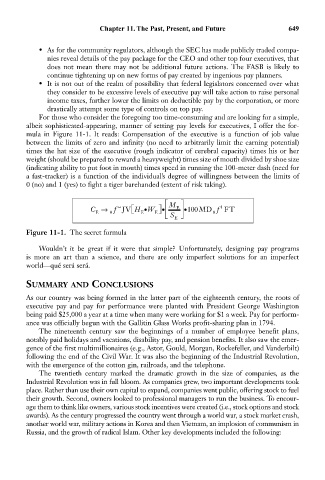Page 664 - Bruce Ellig - The Complete Guide to Executive Compensation (2007)
P. 664
Chapter 11. The Past, Present, and Future 649
• As for the community regulators, although the SEC has made publicly traded compa-
nies reveal details of the pay package for the CEO and other top four executives, that
does not mean there may not be additional future actions. The FASB is likely to
continue tightening up on new forms of pay created by ingenious pay planners.
• It is not out of the realm of possibility that federal legislators concerned over what
they consider to be excessive levels of executive pay will take action to raise personal
income taxes, further lower the limits on deductible pay by the corporation, or more
drastically attempt some type of controls on top pay.
For those who consider the foregoing too time-consuming and are looking for a simple,
albeit sophisticated-appearing, manner of setting pay levels for executives, I offer the for-
mula in Figure 11-1. It reads: Compensation of the executive is a function of job value
between the limits of zero and infinity (no need to arbitrarily limit the earning potential)
times the hat size of the executive (rough indicator of cerebral capacity) times his or her
weight (should be prepared to reward a heavyweight) times size of mouth divided by shoe size
(indicating ability to put foot in mouth) times speed in running the 100-meter dash (need for
a fast-tracker) is a function of the individual’s degree of willingness between the limits of
0 (no) and 1 (yes) to fight a tiger barehanded (extent of risk taking).
⎡ M ⎤
∞
C → f JV ⎡ ⎣ H • W ⎤ •⎢ E ⎥•100 MD f FT
1
E 0 E E⎦ 0
⎣ S ⎦
E
Figure 11-1. The secret formula
Wouldn’t it be great if it were that simple? Unfortunately, designing pay programs
is more an art than a science, and there are only imperfect solutions for an imperfect
world—qué será será.
SUMMARY AND CONCLUSIONS
As our country was being formed in the latter part of the eighteenth century, the roots of
executive pay and pay for performance were planted with President George Washington
being paid $25,000 a year at a time when many were working for $1 a week. Pay for perform-
ance was officially begun with the Gallitin Glass Works profit-sharing plan in 1794.
The nineteenth century saw the beginnings of a number of employee benefit plans,
notably paid holidays and vacations, disability pay, and pension benefits. It also saw the emer-
gence of the first multimillionaires (e.g., Astor, Gould, Morgan, Rockefeller, and Vanderbilt)
following the end of the Civil War. It was also the beginning of the Industrial Revolution,
with the emergence of the cotton gin, railroads, and the telephone.
The twentieth century marked the dramatic growth in the size of companies, as the
Industrial Revolution was in full bloom. As companies grew, two important developments took
place. Rather than use their own capital to expand, companies went public, offering stock to fuel
their growth. Second, owners looked to professional managers to run the business. To encour-
age them to think like owners, various stock incentives were created (i.e., stock options and stock
awards). As the century progressed the country went through a world war, a stock market crash,
another world war, military actions in Korea and then Vietnam, an implosion of communism in
Russia, and the growth of radical Islam. Other key developments included the following:

